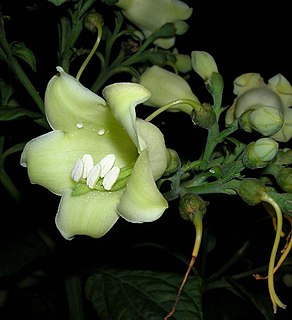
Gentiana acaulis, the stemless gentian, or trumpet gentian, is a species of flowering plant in the family Gentianaceae, native to central and southern Europe, from Spain east to the Balkans, growing especially in mountainous regions, such as the Alps and Pyrenees, at heights of 800–3,000 m (2,625–9,843 ft).

Gentianaceae is a family of flowering plants of 103 genera and about 1600 species.

The Loganiaceae are a family of flowering plants classified in order Gentianales. The family includes up to 13 genera, distributed around the world's tropics. There are not any great morphological characteristics to distinguish these taxa from others in the order Gentianales.

Gelsemiaceae is a family of flowering plants, belonging to the order Gentianales. The family contains only three genera: Gelsemium, Mostuea and Pteleocarpa. Gelsemium has three species, one native to Southeast Asia and southern China and two native to Central America, Mexico, and the southeastern United States. The eight species of Mostuea are native to tropical areas of South America, Africa, and Madagascar. The two genera were formerly classified in the family Loganiaceae. Pteleocarpa was originally placed in Boraginaceae or in its own family Pteleocarpaceae, but it is most closely related to Gelsemiaceae with which it shares significant characters.

Strychnos is a genus of flowering plants, belonging to the family Loganiaceae. The genus includes about 100 accepted species of trees and lianas, and more than 200 that are as yet unresolved. The genus is widely distributed around the world's tropics and is noted for the presence of poisonous indole alkaloids in the roots, stems and leaves of various species. Among these alkaloids are the well-known and virulent poisons strychnine and curare.

The genus Macrocarpaea, with 105 species and two hybrids of 0.5 m herbs, shrubs, epiphytes and small trees to 10 m tall, is the largest genus of the tribe Helieae of the gentian family (Gentianaceae). Species of Macrocarpaea have diurnal and nocturnal pollinators, visited during the day by hummingbirds, insects and butterflies, and at night by bats, moths and many different kinds of insects. The common name for the genus is 'Moon-gentian'. No species are known in cultivation.
The American Society of Plant Taxonomists (ASPT) is a botanical organization formed in 1935 to "foster, encourage, and promote education and research in the field of plant taxonomy, to include those areas and fields of study that contribute to and bear upon taxonomy and herbaria", according to its bylaws. It is incorporated in the state of Wyoming, and its office is at the University of Wyoming, Department of Botany.
Neuburgia is a genus of plants in the family Loganiaceae. It is native to the Bismarck Archipelago, Caroline Islands, Fiji, Maluku Islands, New Caledonia, New Guinea, Philippines, Solomon Islands, Sulawesi, and Vanuatu. It contains the following species :

Voyria, commonly known as ghostplants, is a genus of 20 species of herbaceous perennial plants, belonging to the family Gentianaceae. They are mostly native to warm temperate and tropical regions of the Caribbean, Central America and South America, except for V. primuloides, which is found in West and Central Africa. V. parasitica reaches as far north as the Everglades in Florida.

Cerro de la Neblina, also known as Serra da Neblina in Brazil and Sierra de la Neblina in Venezuela, is a sandstone massif located in the northern Amazon Basin. It is a tilted, heavily eroded plateau, with a deep canyon in its central portion, drained by the Baria River.

Death of Karen Fischer and Christian Struwe is about two German journalists working for Deutsche Welle who were shot on 7 October 2006 in a tent they had pitched alongside a road near Baghlan in Afghanistan, while they were doing research for a freelance documentary. They were the first foreign journalists killed after the 2001 invasion in the War in Afghanistan
These are the results of 2019 BWF World Senior Championships' 45+ events.

Symbolanthus, the ring‐gentians, are a genus of flowering plants in the family Gentianaceae, native to the montane tropics of southern Central America and northern and eastern South America.
Yanomamua is a genus of flowering plants belonging to the family Gentianaceae.
Chelonanthus is a genus of flowering plants belonging to the family Gentianaceae.
Chorisepalum is a genus of flowering plants belonging to the family Gentianaceae.

Lisianthius is a genus of flowering plants belonging to the family Gentianaceae.

Potalia is a genus of flowering plants belonging to the family Gentianaceae.
Sipapoantha is a genus of flowering plants belonging to the family Gentianaceae.
These are the results of 2021 BWF World Senior Championships' 45+ events.











